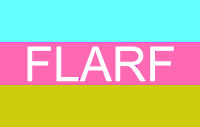
in all its clashing-color glory
(cyan, hot pink, and caca d’oie)
I never quite understood flarf. For awhile, I thought people were writing it to send in to vanity contests to prove the contest standards were laughably low (a kind of analogue to 419-baiting). I thought it was purely a ruse. Having a go amidst some lively banter over on Amy King’s blog has convinced me otherwise. I think flarf can be good for so-called serious poets who are dedicated to other modes–and even liberating.
There is a story, perhaps apocryphal (scroll down), that Abraham Lincoln encouraged at least one member of his staff on one occasion to write an angry letter and burn it, and that he did so himself as a therapeutic exercise. I have certainly done something similar (akin to Cameron’s “morning pages”) and found great benefit. It occurs to me that if being free to write a diatribe full of unsavory and inappropriate comments can actually make you a better diplomat, perhaps being free to write really bad poetry complete with similar trappings can actually make you a better poet.
Poetry can become so serious.
By trying to be bad, the limitation of success is immediately lifted. The only way to succeed is to try hard not to succeed, to get all the worst tricks, the farthest leaps, the most shocking words and least likely turns of phrase out of one’s system. Whether or not this stuff should be published, of course, depends on how good you are at spotting the beauty in badness. Yet sharing flarf can be liberating as well–especially when good poets show off bad stuff.
Spending so much time on the right words and phrasing and tone and texture (and etc.) of a piece can be exhausting. In the end, we can come to crave a tantrum of badness to balance the scales–and flarf is a perfect outlet. So go on–be bad. Really bad. How low can you go?